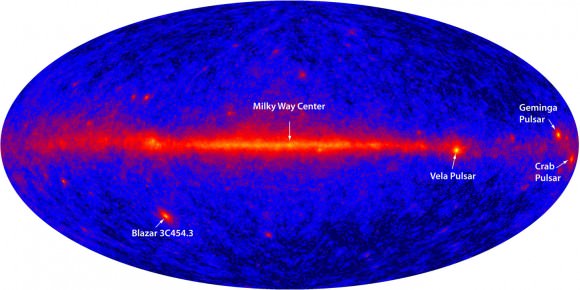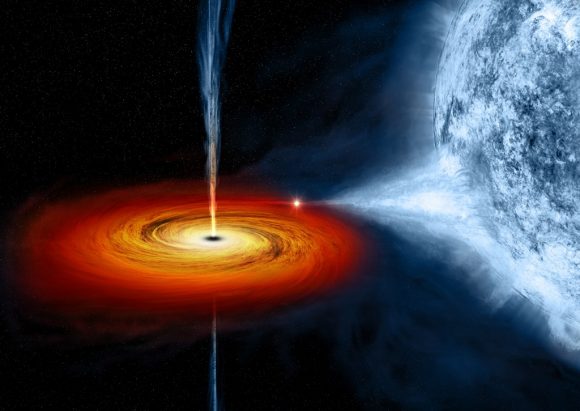Pulsars are what remains when a massive star undergoes gravitational collapse and explodes in a supernova. These remnants (also known as neutron stars) are extremely dense, with several Earth-masses crammed into a space the size of a small country. They also have powerful magnetic fields, which causes them to rotate rapidly and emit powerful beams of gamma rays or x-rays - which lends them the appearance of a lighthouse.
In some cases, pulsars spin especially fast, taking only milliseconds to complete a single rotation. These "millisecond pulsars" remain a source of mystery for astronomers. And after following up on previous observations, researchers using the Low Frequency Array (LOFAR) radio telescope in the Netherlands identified a pulsar (PSR J0952?0607) that spins more than 42,000 times per minute, making it the second-fastest pulsar ever discovered.
The study which described their findings, titled "LOFAR Discovery of the Fastest-spinning Millisecond Pulsar in the Galactic Field", recently appeared in The Astrophysical Journal Letters. Led by Dr. Cees Bassa, an astrophysicist from the University of Utrecht and the Netherlands Institute for Radio Astronomy (ASTRON), the team conducted follow-up observations of PSR J0952?0607, a millisecond pulsar located 3,200 to 5,700 light-years away.

An all-sky view in gamma ray light made with the Fermi gamma ray space telescope. Credit: NASA/DOE/International LAT Team
This study was part of an ongoing LOFAR survey of energetic sources originally identified by NASA's Fermi Gamma-ray space telescope. The purpose of this survey was to distinguish between the gamma-ray sources Fermi detected, which could have been caused by neutron stars, pulsars, supernovae or the regions around black holes. As Elizabeth Ferrara, a member of the discovery team at NASA's Goddard Space Center, explained in a NASA press release:
"Roughly a third of the gamma-ray sources found by Fermi have not been detected at other wavelengths. Many of these unassociated sources may be pulsars, but we often need follow-up from radio observatories to detect the pulses and prove it. There's a real synergy across the extreme ends of the electromagnetic spectrum in hunting for them."
Their follow-up observations indicated that this particular source was a pulsar that spins at a rate of 707 revolutions (Hz) per second, which works out to 42,000 revolutions per minute. This makes it, by definition, a millisecond pulsar. The team also confirmed that it is about 1.4 Solar Masses and is orbited every 6.4 hours by a companion star that has been stripped down to less than 0.05 Jupiter masses.
The presence of this lightweight companion is a further indication of how the spin of this pulsar became so rapid. Over time, matter would have been stripped away from the star, gradually accreting onto PSR J0952?0607. This would not only raise its spin rate but also greatly increase its electromagnetic emissions. The process continues to this day, with the star becoming increasingly smaller as the pulsar becomes more energetic.

Artist's impression of a pulsar siphoning material from a companion star. Credit: NASA
Because of the nature of this relationship (which can only be described as "cannibalistic"), systems like PSR J0952?0607 are often called "black widow" or "redback" pulsars. Most of these systems were found by following up on sources identified by the Fermi mission, since the process has been known to result in a considerable amount of electromagnetic radiation being released.
Beyond the discovery of this record-setting pulsar, the LOFAR discovery could also be an indication that there is a new population of ultra-fast spinning pulsars in our Universe. As Dr. Bassa explained:
"LOFAR picked up pulses from J0952 at radio frequencies around 135 MHz, which is about 45 percent lower than the lowest frequencies of conventional radio searches. We found that J0952 has a steep radio spectrum, which means its radio pulses fade out very quickly at higher frequencies. It would have been a challenge to find it without LOFAR."
The fastest spinning pulsar known, PSR J1748-2446ad, spins just slightly faster than PSR J0952?0607 - reaching a rate of nearly 43,000 rpm (or 716 revolutions per second). But some theorists think that pulsars could spin as fast as 72,000 rpm (almost twice as fast) before breaking up. This remains a theory, since rapidly-spinning pulsars are rather difficult to detect.
But with the help of instrument like LOFAR, that could be changing. For instance, both PSR J1748-2446ad and PSR J0952?0607 were shown to have steep spectra - much like radio galaxies and Active Galactic Nuclei. The same was true of J1552+5437, another millisecond pular detected by LOFAR which spins at 25,000 rpm.
As Ziggy Pleunis - a doctoral student at McGill University in Montreal and a co-author on the study - indicated, this could be a sign that the fastest-spinning pulsars are just waiting to be found.
"There is growing evidence that the fastest-spinning pulsars tend to have the steepest spectra," he said. "Since LOFAR searches are more sensitive to these steep-spectrum radio pulsars, we may find that even faster pulsars do, in fact, exist and have been missed by surveys at higher frequencies."
As with many other areas of astronomical research, improvements in instrumentation and methodology are allowing for new and exciting discoveries. As expected, some of the things we are finding are forcing astronomers to rethink more than a few previously-held assumptions about the nature and limits of certain phenomena.
Be sure to enjoy this NASA video that explains "black widow" pulsars and the ongoing search to find them:
Further Reading: NASA, Astrophysical Journal Letters
No comments:
Post a Comment